New nuclear imaging techniques make tau tangles in the brain visible
New nuclear imaging techniques help to detect a key factor involved in Alzheimer“s disease (AD) much earlier and more precisely than before. Recently developed tracers, used with positron emission tomography (PET) make tau tangles in the brain visible. For the first time these deposits which cause severe neuronal malfunctions can be identified and investigated „live“ in the brains of AD patients long before the onset of noticeable mental impairment. „This is an important step towards our goal to develop efficient drugs to fight and eventually cure AD“, says Dr Silvia Morbelli, expert of the European Association of Nuclear Medicine (EANM).
Many important details of the causes and the progress of AD remain to be elucidated. However, recent research results in the field of nuclear imaging have now brought about a major breakthrough in the diagnosis of the disease, raising hopes for early detection and targeted therapeutic approaches. Over the last few years, PET imaging has already enabled the visualization of -amyloid plaques (one of the hallmarks of AD) in the spaces between nerve cells. Now several recently developed PET tracers make it possible to track down tau deposits in the brains of AD patients too. Tau protein is an important building block of the so-called cytoskeleton, which is essential for the proper working of the nerve cells of the brain. In AD patients this protein undergoes changes that trigger the breakdown of the cytoskeleton. At the same time, unbound tau proteins clump together forming neurofibrillary tangles. The harmful impact of tau tangles on brain function is even more clearly established than that of beta-amyloid, making tau deposits a key suspect as a mediator of neurodegeneration. Before this recent breakthrough, these tau tangles could only be analyzed in post mortem brains.
Illuminating tau“s destructive potential
Based on these findings a neuroimaging research group of the University Hospital of Cologne (Germany) has now managed to precisely localize and measure tau tangles in AD patients and attribute them to corresponding neuronal malfunctions. The new tracers were used to measure tau tangles while also studying neuronal dysfunction with radioactively labelled glucose and amyloid tracers to measure amyloid plaques in the same subjects. A link between brain deposits and neuronal dysfunction could only be found for the tau tangles but not for amyloid plaques, thus highlighting the role of tau for the understanding of the development of AD. „The fact that the existing amyloid imaging technique is now able to be used in conjunction with tau imaging will allow us to study these events in patients in a much more comprehensive fashion“, says Dr Silvia Morbelli.
Opening up new treatment avenues
While imaging technologies are advancing rapidly, the development of effective treatments is still lagging behind. Against this backdrop amyloid imaging has already proven its value as it can identify plaques 10 to 15 years before the onset of cognitive symptoms. The same opportunity now exists for the detection of tau tangles. Even though there is no cure so far, certain medications can reduce the symptoms and thus preserve the patients“ mental abilities to a certain degree for a limited time span. „With the emergence of tau PET ligands, drug companies developing new therapeutics designed to halt or reverse AD now have the opportunity to test and monitor their drugs at an early stage of the disease process. The earlier a treatment is started, the greater are the chances of it being effective.“ says Prof Antony Gee, Chairman of the EANM Drug Development committee.
At present, many clinical trials evaluating potentially disease-modifying drugs only enroll AD patients who have been shown to have amyloid plaques using PET. However, with the discovery of tau PET tracers, alternative inclusion criteria can be considered expanded to tau tangles for the evaluation of new AD therapeutics. „Distinguishing more accurately between the clinical consequences of anti-tau and anti-amyloid effects will help to facilitate more effective and faster clinical trials. These are prerequisite for the identification of new AD therapies“, says Dr Silvia Morbelli.
Furthermore: The novel tau tracers are anticipated to help major breakthroughs for the investigation and diagnosis of non-AD related neurodegenerative diseases in which tau deposits play a similarly crucial role. This includes other types of dementia and parkinsonian syndrome.
What is nuclear medicine? Please watch our short tutorial. (http://www.whatisnuclearmedicine.com)
Follow EANM on facebook. (https://www.facebook.com/officialEANM.)
Presseagentur für Medizinthemen
Kontakt
impressum health & science communication
Frank von Spee
Hohe Brücke 1
20459 Hamburg
040 31786410
vonspee@impressum.de
http://www.impressum.de






